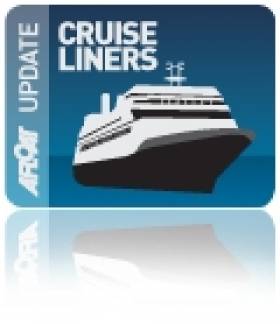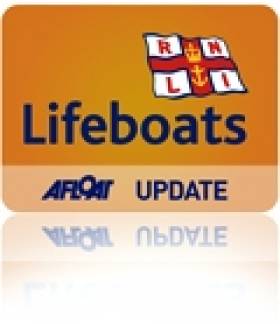Displaying items by tag: Galway
Remembering The Unique Character Of The Claddagh
#Claddagh - The Irish Post has a revealing look at one of Ireland's most unique communities – the people of the Claddagh.
Today very much part of a vibrant Galway, the Claddagh was once very distinct from the city just across the mouth of the Corrib.
Indeed, there's much more to the area and its history than the famous Claddagh Ring.
Comparable to communities like the Amish in the United States, the Claddagh people were once easily distinguished by their anachronistic style of dress – and their devotion to the fishing industry.
Lace-making and net-making were once ubiquitous skills in an area where all boys grew up to be fishermen, though that was long ago.
However, there has been a revival of old traditions such as the recent Galway hooker boatbuilding project.
And it's a unique history that deserves to be celebrated with its own maritime museum, says one local historian, as previously reported on Afloat.ie.
The Irish Post has much more on the story HERE.
Dublin Backed Out of Tall Ships Races Bid Over Costs
#TallShips - Dublin backed out of its bid to host the 2019 Tall Ships Races after Dublin City Council deemed the €3 million costs too high.
As the Irish Independent reports, the council said in defending the decision that the cost "represents a very significant funding implication for DCC", describing it as bigger than its annual budget for festivals and events throughout the year – including the now annual Riverfest.
Business leaders described the move as "disappointing" in light of the expected €30 to €75 million boost to the local economy from an event that attracted over a million visitors when it was last staged in the capital in 2012.
As previously reported, Galway is already stepping into the breach by mounting its own bid to host the tall ships in the same harbour that welcomed the Volvo Ocean Race in 2012 and 2009.
The Irish Independent has more on the story HERE.
Indoor Rowing Blitz Brings Buzz to Trinity
#Rowing: The School Indoor Rowing Blitz in Trinity College drew hundreds of competitors. Borris Vocational School from Carlow won the Girls under-15 section ahead of Gaelcholáiste Ceatharlach, and Limerick school Laurel Hill won the girls under-14 category. The top under-14 boys’ team were CBC from Monkstown.
For Full Results, See Attachment Below
School Indoor Rowing Blitz, Trinity College (Selected Results)
Boys
Under 14: 1 CBC Monkstown 7 min. 0.7 secs, 2 Presentation, Cork - Panthers 7:24:9. Under 13: 1 CBC Monsktown 7:51:0, 2 St Joseph’s, Galway One 7:53.9, 3 St Joseph’s, Galway Three 8:13.7.
Girls
Under 15; 1 Borris Vocational School – Barrow Barrowers 7:45.4, 2 Gaelcholáiste, Ceatharlach 7:53.1, 3 Cois Life, Lucan 8:32.7.
Under 14: 1 Laurel Hill, Limerick 7:43:3, 2 Coláiste Iognáid 7:44:5, 3 Borris Vocational School - Barrow Blitzers 7:44:8. Under-13: 1 Laurel Hill, Limerick 7:48:0. 2 Col Iognaid 8:20:2, 3 Gael Scoil, Carlow 8:20:5
Galway City Councillors Adopt New Six-Year Tourism Blueprint
#Tourism - Galway's status as the only city on the Wild Atlantic Way is at the centre of a new six-year tourism blueprint for the City of the Tribes.
As the Connacht Tribune reports, the Tourism Sustainability Strategy 2015-2021 – developed from search commissioned by Galway City and County Councils – recommends that a 'master brand' be created to capitalise on the city's unique position in the West of Ireland.
Plans include developing and marketing Galway as a transport and accommodation hub for the Wild Atlantic Way, as well as creating new spin-off cultural and heritage trails, and extending the tourist season with the likes of new city-based festivals.
The Connect Tribune has much more on the story HERE.
Govt 'Stonewalling' New Galway Flood Risk Plans Says Councillor
#FloodRisk - The Government is "stonewalling" new flood plans for at-risk areas near inland waters in Co Galway, according to a county councillor and general election candidate.
As the Galway Advertiser reports, Cllr Anne Rabbitte claims that the Office of Public Works (OPW) has refused to meet with Galway councillors to advise on new flood risk plans for Headford on Lough Corrib, Portumna on Lough Derg and Ballinasloe on the River Suck, a tributary of the Shannon.
As a result, says Cllr Rabbitte, the council is working from draft maps and being "over-cautious" in its estimates, adversely influencing "insurance costs and resale opportunities" for homes in areas not affected by the last serious floods in 2009.
The Galway Advertiser has much more on the story HERE.
Council Warns Connemara Salmon Farms Over Illegal Freshwater Extraction
#FishFarm - Connemara's salmon farming industry has vowed to ensure it abides by all statutory regulations following the recent discovery of illegal freshwater extraction in the Kilkieran Bay area.
As Galway Bay FM reports, Galway County Council has been moved to write to the region's biggest salmon farming companies over their use of freshwater for disease control in their salmon farms.
This was prompted by the discovery of an illegal pumping system at Loch An Mhuilinn, similar to the unauthorised pipeline from Loughaunore that got Marine Harvest Ireland into trouble with the authorities last year.
Marine Harvest, along with the region's biggest producer Bradán Beo Teo, was sent a warning letter by the council in the wake of the latest find, for which it is not yet known who is responsible. The Connacht Tribune has more on the story HERE.
Galway Lifeboat Rescues Two From Powerboat
#RNLI - Galway RNLI's lifeboat launched yesterday evening (Tuesday 8 September 2015) to rescue two people from a 25-foot powerboat that got into difficulty off Salthill on Galway Bay.
The cabin cruiser went aground west of Blackrock Tower at about 6.40pm as the tide was going out.
Galway's lifeboat crew launched at 7pm and, on arrival at the scene, two crew members disembarked and swam to the powerboat, where a father and son were still on board.
The lifeboat voluntreers then anchored the boat and escorted the two men safely to Blackrock. Much later that evening the lifeboat returned to the powerboat to refloat it at high water.
Galway RNLI helm David Oliver says the two people were not hurt in the incident. “They were new to boating and it was a lesson learned for them,” he says.
The volunteer lifeboat crew on this callout were Oliver, Dan King, Stephanie Carr and Ian O’Gorman.
Galway Welcomes Second Visitor Of 2015 Cruise Season
#CruiseLiners - Galway welcomed its second cruise liner of the 2015 season this week, as the Connacht Tribune reports.
The Amadea as previously reported brought more than 600 passengers and 300 crew to the City of the Tribes on Wednesday 20 May for the fleeting visit, with the liner on her way to her next port of call in Cork Harbour by 5pm.
Four more cruises are expected in the city this summer, with the next being the Prinsendam on 12 June
The biggest will come on 4 August with the 1,000-plus-passenger Crystal Serenity, sister of the Crystal Symphony which cancelled her anchorage call due to bad weather last August.
The Connacht Tribune has more on the story HERE.
Galway Lifeboat Rescues Woman Swept Out To Sea
#RNLI - A woman was recovering in hospital in Galway last night (Wednesday 6 May) after being rescued by Galway RNLI lifeboat.
The alarm was raised by members of the public who spotted the woman in the River Corrib being swept out to sea.
They alerted the emergency services and a 'blanket' callout was made to the lifeboat, Garda, Irish Coast Guard, Galway Fire Brigade and the ambulance service at around 11.41pm.
Galway RNLI launched within minutes with helm Shane Folan and crew Dan King, Emma Hennessy and David Badger, and the woman was quickly located near waters at the Galway Enterprise Park at Galway Docks.
She was taken on board the lifeboat and brought ashore where she was transferred to a waiting ambulance and taken to University Hosptial Galway.
Galway RNLI shore crewmember John Byrne said: "The new emergency service plan for river rescues worked very well with all rescue services on the scene very quickly."
The rescue came a day after Clifden RNLI aided two lobster fishermen yesterday after their boat got into difficulty on the Connemara coastline.
At approximately 10.30am on Tuesday 5 May, Clifden RNLI's volunteer lifeboat crew was requested to launch by the Irish Coast Guard and go to the aid of two lobster fishermen in difficulty off the Aughrus peninsula.
Having experienced engine failure, the boat was drifting dangerously close to the rocks when its crew raised the alarm.
The Atlantic 85 inshore lifeboat Benjamin Downing Fairbridge was launched and was on the scene within 10 minutes of leaving shore.
Lifeboat helm Bernard Whelan and volunteer crew members Kenneth Flaherty, Joe Acton and Owen Hayes then towed the two fishermen in their boat back to Rossadillisk pier in Cleggan.
Speaking following the callout, Clifden RNLI lifeboat press officer Catherine Pryce said: "The crew responded rapidly and were delighted to be able to assist the fishermen."






























































